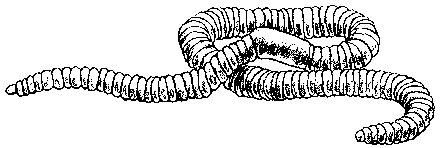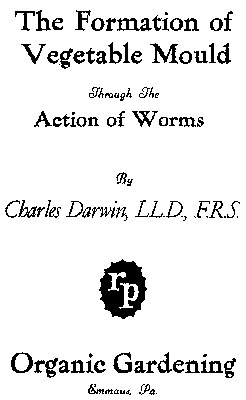 |
| Illustration from “Earthworm Biology and Production,” Leaflet 2828, University of California Cooperative Extension, Berkeley, Calif., 1977. |
By Jean Ann Pollard
Always with us and the farmer’s friend. Right? Is that what you think when you think ‘gardening’ – when you see those long, red angleworms surfacing all over the lawn and under the rhubarb after rain?
Probably we all do. But how many references to angleworms have you noted in the index sections of books about farming and gardening? As far as I can see, they’re not indexed in the Garden and Farm Books of Thomas Jefferson edited by Robert C. Baron; Clarence Albert Day doesn’t mention them in his 1954 A History of Maine Agriculture 1604-1860; Howard Russell doesn’t list them in his 1976 A Long, Deep Furrow: Three Centuries of Farming in New England; they’re not even indexed in Eliot Coleman’s gardening books, and he’s certainly aware of them.
In 1973, Peter Tompkins and Christopher Bird did mention earthworms in The Secret Life of Plants. “We live,” they said, “from about eight inches of topsoil, containing earthworms, bacteria, fungi, and other microscopic forms of life, that provides us with vegetation, trees, insects, and animals. The only inexhaustible wealth is a fertile soil. In the coming age,” they add prophetically, “proper nutrition from a fertile soil will be the first source of wealth.”
Still, in 1994, the enormous Taylor’s Master Guide to Gardening gives angleworms only one small paragraph, and James Trager’s Food Chronology ignores them but for one reference on page 649, where he quotes a University of California professor who urges, among other items, their use as protein: They could be “salted to taste like beef jerky,” he suggests. Anyone for a treat?
Earthworms do get prime mention in articles and advertising about growing your own bait for fishing, or buying a pound or two for composting kitchen refuse. But those worms are Lumbricus rubellus, otherwise known to the cognoscenti as red wigglers.
Do “real” angleworms – as those long, segmented, red earthworms burrowing under the wet rhubarb are commonly known in Maine – matter? Shepherd Ogden in Straight-ahead Organic, says an emphatic yes. Earthworms, he says – and I’m pretty sure he’s referring to Lumbricus terrestris, can number “up to half a million an acre.” In fact, such an earthworm can “move stones up to fifty times its own weight as it burrows through the soil, sometimes to a depth of twelve feet or more,” and the amount of soil displaced by such activity “is up to five tons per acre per year.” (They even take up onion moving, as my husband and I discovered one year.)
Why all this activity? Angleworms virtually eat their way through the earth, leaving behind mud-like “castings” that are five times as rich in nitrogen, phosphorus and potassium as most nearby soil. And that’s not all. A lubricating mucus coating that allows them to wriggle easily through tough soils stays behind on tunnel walls, binding soil particles, helping maintain soil structure and helping drain and aerate the soil. All of this munching and tunneling naturally mixes raw materials with the pH-balancing digestive juices and the bacteria of the worm’s gut to produce one of the best “manures” available. In fact, an active earthworm may produce its own weight in fertile castings each day.
Well, gardeners have always believed that crawlers were beneficial, so we’re all nodding our heads. But there’s a fascinating side issue to the story. Lumbricus terrestris – the familiar ‘night crawler,’ the ‘angleworm’ – isn’t a native American! North of a line from Massachusetts to Iowa, North America has no native earthworms, researchers say. The reason? When the last big glaciers covered most of Maine and a lot of the rest of the country a mile high, they apparently wiped out our worms.
So where did our garden burrowers and fishline tidbits come from? Apparently they arrived with European settlers. Counting backward, if the glaciers left around 10,000 years ago, that means it took until the 1600s for angleworms to get here. Did they hitchhike in ship ballast? Did they curl up in the root balls of plants? In hay? Did their egg casings get caught on people’s boots? Horses’ hooves? Even today, fishermen sometimes lose bait worms, which then populate areas around resorts. In fact, anywhere there’s decent soil, they make themselves at home.
According to The New Encyclopaedia Britannica, earthworms occur in virtually all soils of the world in which “moisture and organic content are sufficient to sustain them.” As for the particular earthworm called the angleworm, it “can be any one of more than 1,800 species of terrestrial worms” of the order Oligochaeta, class Chaetopoda, phylum Annelida – “in particular, members of the genus Lumbricus.” Thirteen species were introduced from Europe and now occur in the eastern United States, L. terrestris being the most common.
Intriguing questions remain. Has anyone figured out with any amount of exactitude just who brought the first crawler to New England, and how, and when? And how, for goodness’ sakes, did curvaceous angleworms get the name ‘angle worm’? Some suggest it comes from the way their bodies make an angle when they wiggle; others say it’s because they’re used as fish bait by anglers. We invite readers of The MOF&G to send us their ideas about angleworm etymology!
Bibliography
Baron, Robert C. ed., The Garden and Farm Books of Thomas Jefferson, Fulcrum, Colorado, 1987.
Coleman, Eliot. The New Organic Grower’s Four-Season Harvest, Chelsea Green Publishing Co., Vermont.
Coleman, Eliot. The New Organic Grower, Chelsea Green, Vermont.
Milius, S., “Worm Attacks,” (quoting Patrick Bohlen of Archbold Biological Station in Lake Placid, Florida, a chronicler of earthworm invasions) Science News, Vol. 162, Nov. 30, 2002, p. 341.
The New Encyclopaedia Britannica, Vol. 4, 1988. p. 324.
Ogden, Shepherd. Straight-ahead Organic, Chelsea Green Publishing Co., Vermont, 1992, pp. 76-77. Shepherd and Ellen Ogden are co-founders of the Cook’s Garden catalog, one of North America’s preeminent organic seed suppliers, located in Londonderry, Vermont.
Tompkins, Peter, & Christopher Bird. The Secret Life of Plants, Harper & Row, N.Y., 1973, p. 257.
Taylor’s Master Guide to Gardening, Houghton Mifflin Co., NY, 1994, p.527.
Trager, James, The Food Chronology, Henry Holt, N.Y., 1995 (Prof. Calvin W. Schwabe of the Univ. of Calif., Davis, mentioned on page 649).
 |
Earthworm Aficionados
Famous names are connected with worms. Aristotle called earthworms the “intestines of the soil.” Darwin wrote a book called The Formation of Vegetable Mould through the Action of Worms, in which he said that vegetation would degenerate to the vanishing point without them. He added, “It may be (doubtful) whether there are many other animals which have played so important a part in the history of the world as these lowly organized creatures.” In short, he concluded that all the vegetable mould over the whole country of England had passed many times through the intestinal canals of worms. And now the same is true of New England.
Is There a Downside to Earthworms?
A study showing that the goblin fern (Botrychium mormo) had disappeared in nine of 28 spots in Chippewa National Forest in Minnesota documented a thin layer of leaf litter in those spots and a forest floor “wriggling with the earthworm Lumbricus rubellus” in eight of the nine spots. Researcher Michael Gundale believes the worm decomposed enough leaf litter to harm the ecology needed by the fern (See Milius reference above). Likewise, biologists Paul Hendrix and Patrick Bohlen suggest that exotic earthworms could outcompete native earthworms (where they exist) and disrupt native ecosystems. They suggest regulations to reduce importation of some exotic earthworms. (Hendrix, Paul F. and Patrick J. Bohlen, “Exotic Earthworm Invasions in North America: Ecological and Policy Implications,” BioScience 52(9), Sept. 2002, p. 801-811.
Earthworms and Soil Health
• In soils with high earthworm populations, 30 to 50 near-pencil-sized vertical tunnels per square yard are common. Gently sloping land under a midsummer corn canopy can absorb a 4-inch rainfall in two hours with virtually no runoff when abundant earthworm populations are present. And in a clay loam soil in Minnesota, at the 3- to 6-inch soil depth, the abundance of channels from roots or worms was approximately three times higher under no-till than where the soil was fall plowed. (“Drought Resistant Soils,” by Preston Sullivan, Appropriate Technology Transfer for Rural Areas [ATTRA], available at www.attra.org/attra-pub/drought.html.)
• Fields that are “tilled” by earthworm tunneling can absorb water at a rate 4 to 10 times that of fields lacking worm tunnels (“Sustainable Soil Management,” by Preston Sullivan, see ATTRA above; quoting Clive A. Edwards and P.J. Bohlen, 1996, Biology and Ecology of Earthworms, Chapman and Hall, New York).
• Vertical earthworm burrows pipe air deeper into the soil, stimulating microbial nutrient cycling at those deeper levels. When earthworms are present in high numbers, the tillage provided by their burrows can replace some expensive tillage work done by machinery (“Sustainable Soil Management,” above).
• Earthworms thrive where there is no tillage. Generally, the less tillage, the better. Worm numbers can be reduced by as much as 90% by deep and frequent tillage (“Sustainable Soil Management,” above).
• To increase earthworm numbers, leave as much surface residue as possible year ’round. Add animal manure and grow green manure crops. Generally, worms want their food on top and they want to be left alone (“Sustainable Soil Management,” above).
